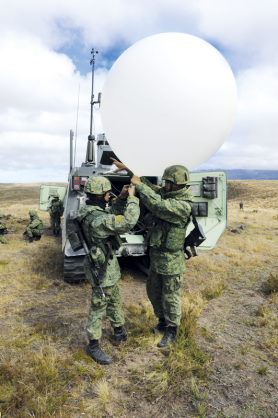ACCOUNTING FOR THE WEATHER
PHOTO // Ong Hong Tat
Artillery is all about being on time and on target and the Field Artillery Meteorological System (FAMS) plays a crucial role in this, as it accounts for how the weather affects the flight path of artillery rounds.
When a golfer drives a ball up into the sky, it is subjected to atmospheric conditions such as wind strength and wind direction. And every one of these conditions plays a part in deciding where the ball will land.
The same happens when artillery rounds are fired.
Several atmospheric factors affect the accuracy of artillery firing. They include wind speed, wind direction, air pressure, humidity and temperature.
To counter all these factors, there is a need to measure each of them at different altitudes in the atmosphere and feed the data to the artillery batteries so that the operators can adjust the trajectories of the guns accordingly.
This is where FAMS comes into the picture.
The weather device
At the heart of FAMS is the Vaisala Radiosonde RS92-SGP, a digital measurement tool containing sensors to measure pressure, temperature and humidity, as well as wind speed and wind direction in the air.
Because it is small and lightweight - measuring 220mm by 80mm by 75mm and weighing about 300grams - the radiosonde can be attached onto a large helium-filled balloon and sent up into the atmosphere.
On the way up, the RS92-SGP measures the various atmospheric conditions at different altitudes and transmits the atmospheric data digitally back to the FAMS unit on the ground.
The systems vehicle
On the ground with the FAMS unit is the systems vehicle. There are two systems vehicles that carry the FAMS equipment in the SAF - the MB290 as well as the All Terrain Tracked Carrier (ATTC) housed in a Bronco chassis.
A crew of six - consisting of the FAMS commander, second-in-command, specialist, signaller, driver and the FAMS operator - mans the ATTC, while the MB290 is manned with an additional FAMS operator and driver.
Each of these vehicles carries the same FAMS equipment, which comprises the Mobile Military System (MMS) sounding system and the Military Automatic Weather Station (MAWS). The ground equivalent of the RS92-SGP radiosonde, the MAWS is attached to the systems vehicle to calculate the conditions at
ground level.
The comparison of the current conditions in the atmosphere (via RS92-SGP) against the standard condition (via MAWS) is known as a meteorological (MET) message. A MET message contains several lines of data, each detailing the different atmospheric conditions at different altitudes.
All the data goes through the MMS sounding system, which acts like the central-processing unit of a computer, before it gets transmitted to the artillery gun batteries.
The artillery gun units will then compensate for the data and thus achieve greater accuracy in firing. It is for all these reasons that FAMS support is required for all artillery live firing.
The current FAMS has been featured in artillery exercises like Exercise Thunder Warrior in New Zealand and Exercise Agni Warrior in India.
The more recent Exercise Thunder Warrior, held from 17 Jan to 1 Feb, saw the Bronco version of the FAMS systems vehicle in action. It took part in the exercise along with the Singapore Self-Propelled Howitzer Primus, a 155mm artillery gun able to hit targets up to 30km away, of the 21st Battalion, Singapore Artillery.










